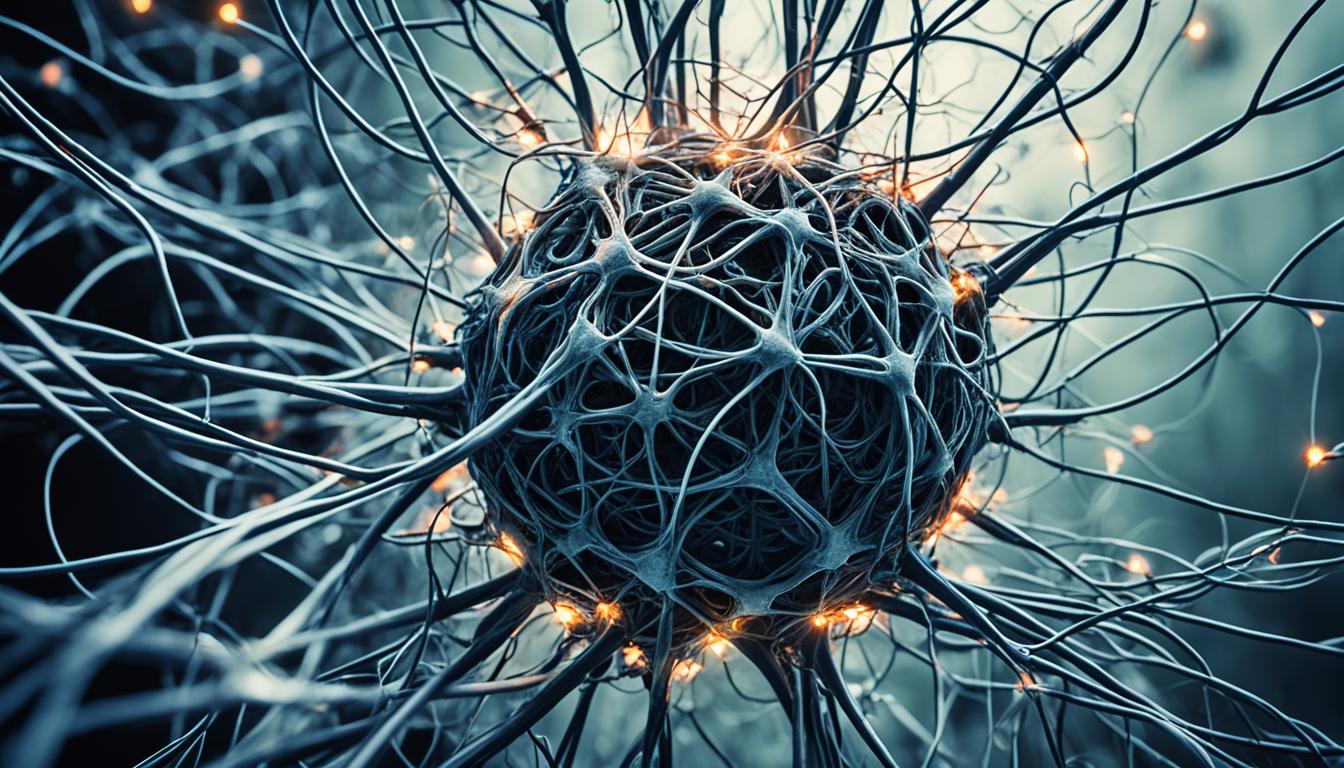Paraneoplastic neurological disorders are rare. They happen when the immune system reacts to a cancerous tumor in a way that attacks the nervous system. These disorders are more likely to affect older adults. Common cancers tied to these syndromes include those of the lung, ovaries, breasts, and lymph nodes.
Symptoms of these disorders are varied. They can make it hard to walk or swallow, cause muscle tone loss, or disrupt coordination. You might also experience slurred speech, memory issues, vision changes, sleep troubles, seizures, feel less in your limbs, and even feel dizzy.
Treating these disorders involves managing the tumor and the autoimmune response. Methods like plasmapheresis and physical therapy can help. Sadly, there’s no straightforward cure. How well a person does mainly relies on when their cancer was found and treated.
Key Takeaways:
- Paraneoplastic neurological disorders are due to an autoimmune reaction that affects the nervous system, linked to cancer.
- They usually show up in middle-aged or older adults, commonly with cancers of the lung, ovaries, breasts, or lymph nodes.
- Signs often include problems with walking or swallowing, memory loss, vision impairments, and seizures.
- Treatment looks at fighting the tumor and the autoimmune issue, but a cure isn’t available yet.
- The chances of getting better depend on the cancer’s stage when identified.
Types of Paraneoplastic Syndromes
Paraneoplastic neurological disorders can impact many parts of the nervous system. They can cause problems with movement, emotions, and memory. Some examples are:
- Cerebellar degeneration: Coordination and balance problems are common.
- Limbic encephalitis: It inflames the brain’s limbic system affecting emotions and memory.
- Encephalomyelitis: It leads to inflammation in the brain, spinal cord, and nerves.
- Opsoclonus-myoclonus syndrome: This shows as quick eye movements and muscle jerks.
- Stiff person syndrome: People experience severe muscle stiffness and spasms.
- Myelopathy: It causes injury in the spinal cord.
- Lambert-Eaton myasthenic syndrome: It brings muscle weakness and fatigue.
- Myasthenia gravis: This leads to muscle fatigue and weakness.
- Neuromyotonia: It causes too many nerve impulses and muscle twitching.
- Peripheral neuropathy: This leads to damage of the peripheral nerves.
- Dysautonomia: It affects the autonomic nervous system, leading to various issues.
Let’s dive deeper into a few examples to better understand these syndromes:
Cerebellar Degeneration
This syndrome targets the cerebellum, which controls movement and balance. It’s linked to cancers like those in the breast, ovary, or lung. Symptoms include issues with coordination, balance, and speech.
Limbic Encephalitis
Limbic encephalitis causes inflammation in the brain’s limbic system, affecting emotions and memory. It is often tied to cancers like small-cell lung or gynecological cancers. People might experience mood changes, memory problems, or behavioral shifts.
Encephalomyelitis
Encephalomyelitis leads to inflammation in the brain, spinal cord, and nerves. It’s known to cause symptoms like cognitive issues, muscle weakness, and sensory problems. This syndrome is commonly linked with lung, breast, and ovarian cancer.
There are many paraneoplastic syndromes, each with its own effects. Early diagnosis and treatment are key to managing these conditions and their effects on the nervous system.
Diagnosis and Treatment of Paraneoplastic Neurological Disorders
Diagnosing paraneoplastic neurological disorders can be tough. This is because symptoms are like other conditions. The presence of certain antigens and antibodies helps to confirm the diagnosis. Tests including blood tests and EEGs are used in diagnosis.
Treating paraneoplastic neurological disorders means dealing with both the tumor and the autoimmune response in the body. Options include taking out the tumor, chemotherapy, and radiation. Also, there are targeted therapies.
Plasmapheresis can help by removing harmful antibodies from the blood for symptom relief. Stem cell therapy is also being explored. Its goal is to repair or replace damaged nerve cells.
Getting involved in clinical trials can be beneficial. It allows patients to help advance the understanding and treatment of these disorders. Trials test new and safe treatment options. They offer access to new methods not widely available.
To see the diagnosis and treatment options in detail, check the table below:
| Diagnostic tests | Treatment options |
|---|---|
|
|
Conclusion
Paraneoplastic neurological disorders are rare. They happen when the immune system attacks the nervous system because of cancer. These disorders can show up in many ways, affecting the nervous system’s different parts with various symptoms.
Diagnosing these disorders is complicated. It needs a team of experts from neurology, oncology, and immunology. They work together to figure out the problem.
The goal of treatment is to deal with the tumor and the immune system’s wrong response. There isn’t a cure yet. But research and new treatments, like stem cell therapy, give hope for better results. Joining clinical trials can help us learn more and find better therapies.

